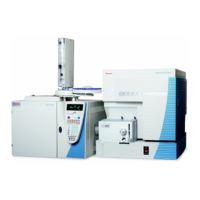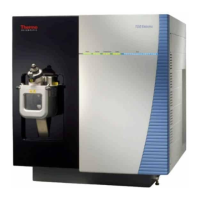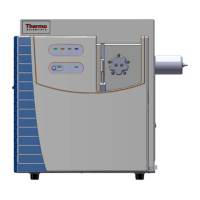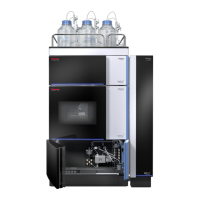4
Daily Operation
Things to Do Before Operating the TSQ System
Thermo Scientific TSQ Series Hardware Manual 65
Compare the current values of the pressures in the vacuum manifold with the values listed in
Tabl e 3. If the current values are higher than normal, you might have an air leak.
If the pressure is high (above 5 × 10
–
5
Torr in the analyzer region), and you have restarted the
system within the last 30 to 60 minutes, wait an additional 30 minutes and recheck the
pressure. If the pressure is decreasing with time, check the pressure periodically until it is
within the typical pressure range of the mass spectrometer.
If the pressure remains high, your system might have an air leak. If you suspect an air leak,
shut down the system as described in the topic “Shutting Down the System Completely” on
page 52. Make a visual inspection of the vacuum system and vacuum lines for leaks. Check
each fitting and flange on the system for tightness, and tighten the fittings or flanges that are
loose. Do not tighten fittings indiscriminately. Pay particular attention to fittings that have
been changed recently or to fittings that have been subjected to heating and cooling. Make
sure that the cover plates of the vacuum manifold are properly seated.
Table 3. Typical pressure readings for TSQ Vantage and TSQ Quantum Ultra
Conditions
Convectron gauge reading (foreline,
ion transfer tube- skimmer region)
Ion gauge reading
(analyzer region)
Collision gas off, ion transfer
tube orifice sealed
less than 0.05 Torr Less than
3×10
–
6
To r r (after
pumping for at least
one hour)
Collision gas off, ion transfer
tube orifice open
0.9 to 1.2 Torr (110 V at 60 Hz)
1.5 to 2.2 Torr (220 V at 50 Hz)
Less than
5×10
–
6
To r r
Collision gas set to 2 mTorr, ion
transfer tube orifice open
0.9 to 1.2 Torr (110 V at 60 Hz)
1.5 to 2.2 Torr (220 V at 50 Hz)
Less than
3×10
–
5
To r r
Table 4. Typical pressure readings for TSQ Quantum Access and TSQ Quantum Access MAX
Conditions
Convectron gauge reading (foreline,
ion transfer tube- skimmer region)
Ion gauge reading
(analyzer region)
Collision gas off, ion transfer
tube orifice sealed
less than 0.05 Torr Less than
3×10
–
6
Torr (after
pumping for at least
one hour)
Collision gas off, ion transfer
tube orifice open
1.2 to 1.8 Torr (110 V at 60 Hz)
1.5 to 2.2 Torr (220 V at 50 Hz)
Less than
5×10
–
6
Torr
Collision gas set to 2 mTorr, ion
transfer tube orifice open
1.2 to 1.8 Torr (110 V at 60 Hz)
1.5 to 2.2 Torr (220 V at 50 Hz)
Less than
3×10
–
5
Torr

